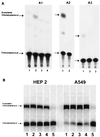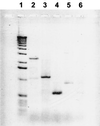Rescue of mumps virus from cDNA
- PMID: 10775622
- PMCID: PMC112006
- DOI: 10.1128/jvi.74.10.4831-4838.2000
Rescue of mumps virus from cDNA
Abstract
A complete DNA copy of the genome of a Jeryl Lynn strain of mumps virus (15,384 nucleotides) was assembled from cDNA fragments such that an exact antigenome RNA could be generated following transcription by T7 RNA polymerase and cleavage by hepatitis delta virus ribozyme. The plasmid containing the genome sequence, together with support plasmids which express mumps virus NP, P, and L proteins under control of the T7 RNA polymerase promoter, were transfected into A549 cells previously infected with recombinant vaccinia virus (MVA-T7) that expressed T7 RNA polymerase. Rescue of infectious virus from the genome cDNA was demonstrated by amplification of mumps virus from transfected-cell cultures and by subsequent consensus sequencing of reverse transcription-PCR products generated from infected-cell RNA to verify the presence of specific nucleotide tags introduced into the genome cDNA clone. The only coding change (position 8502, A to G) in the cDNA clone relative to the consensus sequence of the Jeryl Lynn plaque isolate from which it was derived, resulting in a lysine-to-arginine substitution at amino acid 22 of the L protein, did not prevent rescue of mumps virus, even though an amino acid alignment for the L proteins of paramyxoviruses indicates that lysine is highly conserved at that position. This system may provide the basis of a safe and effective virus vector for the in vivo expression of immunologically and biologically active proteins, peptides, and RNAs.
Figures






References
-
- Afzal M A, Pickford A R, Forsey T, Heath A B, Minor P D. The Jeryl Lynn vaccine strain of mumps virus is a mixture of two distinct isolates. J Gen Virol. 1993;74:917–920. - PubMed
MeSH terms
Substances
Associated data
- Actions
LinkOut - more resources
Full Text Sources
Other Literature Sources
Medical
Miscellaneous

